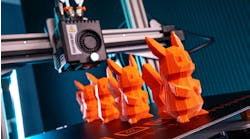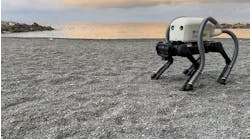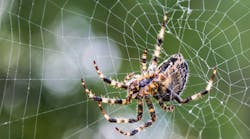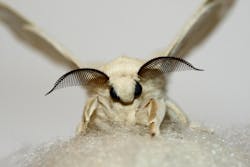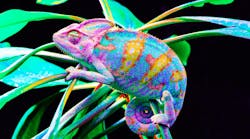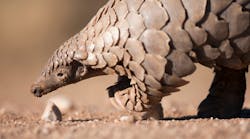Latest from Fun Innovations Friday
Fun Innovations Friday: The Future of Textiles Lies in Spiders
Animals have always been a source of inspiration for modern technologies and designs. In fact, this type of approach to product innovation has a name: biomimicry. Just last week we reported on how the Beckman Institute at the University of Illinois created a chameleon-inspired 3D printing technique that uses one ink to print different colors. In 2016, Siemens researchers created 8-legged 3D printing robots, called SiSpis, that were capable of extruding polylactic acid (PLA), a mixture of cornstarch and sugarcane used in some 3D printing applications. Festo, the robotics company, created an entire bionics department that developed grippers modeled after chameleon tongues, octopus tentacles, and elephant trunks. And of course, we all know Spot the robotic dog from Boston Dynamics.
The list goes on, but I'll stop there as we need to talk about the newest biomimicry invention, which comes from spiders—spider webbing, to be exact—to make a new type of textile fiber.
It makes sense as spider webbing is made up of proteins making it incredibly tough. When you think of a spider web, what characteristics come to mind? It's resilient, tough, sticky, flexible, and lightweight. Because of these characteristics and properties, it's a great contender for textile materials that could be used for military, industrial, and consumer goods products and applications.
This idea comes from Kraig Biocraft Laboratories, a biotech company that was founded in 2008 with the sole reason to research spider silk and its production. The company has been in the process of figuring out how to produce spider silk in commercial quantities. If they could figure out a way, the potential is there to create life-saving ballistic-resistant materials that would be lighter, thinner, more flexible, and tougher than steel.
Normally, you would think you could raise them in colonies to get access to that amount of silk, but spiders are cannibalistic, so that way was ruled out. Instead, the scientists at Kraig figured out how to replicate the proteins that make up the building blocks of the silk, but they then ran into two big barriers. The first barrier they encountered was the inability to form the replicated proteins into a spider silk fiber that had the desired mechanical characteristics. The second barrier was to do this cost-effectively.
Of course, they've found a way to move past these barriers.
Since they couldn't raise spiders in colonies and since they couldn't replicate the silk themselves, they decided to turn to a different animal that could help—the domesticated silkworm.
First, Kraig invented a new technology and acquired the exclusive right to use the patented genetic sequences for numerous fundamental spider silk proteins. Kraig worked with leading universities that developed some of the most relevant genetic engineering technologies. In fact, most of its genetic engineering work takes place inside university laboratories.
So after patenting the genetic sequences of the proteins, Kraig then applied that genetic engineering to the domesticated silkworm—one of the most efficient commercial producers of silk. The silkworm's glands make up 40% of its weight, producing large volumes of a protein called fibroin which is then spun into a composite protein thread, known as silk.
To date, Kraig has created 20 different spider silk fibers based on its proprietary genetic designs which have already been peer-reviewed, and an article was published in the Journal of the National Academy of Sciences. Kraig also states that the term genetically engineered spider silk is used instead of synthetic spider silk as the material is made from genetically engineered silkworms and because the fiber is composed entirely of proteins that are produced naturally by the silkworm.
Kraig’s lead product—Dragon Silk—is spun by lines of its transgenic silkworms and is composed of a unique combination of spider silk protein and silkworm silk protein. Combining both the elasticity and strength elements of native spider silk, Dragon Silk is significantly stronger and more flexible than commercial-grade silk.
| Material Toughness1 | Tensile Strength2 | Weight3 | |
| Dragline Spider Silk | 120,000 to 160,000 | 1,100 to 2,900 | 1.18 to 1.36 |
| Kevlar | 30,000 to 50,000 | 2,600 to 4,100 | 1.44 |
| Steel | 2,000 to 6,000 | 300 to 2,000 | 7.84 |
1Measured by the energy required to break a continuous filament, expressed in joules per kilogram (J/kg). A .357 caliber bullet has approximately 925 joules of kinetic energy at impact. |
|||
2Tensile strength refers to the greatest longitudinal stress the spider silk can bear, measured by force over area in units of newtons per square meter. The measurement here is in millions of pascals. |
|||
3In grams per cubic centimeter of material. |
|||
*Data from Kraig Biocract Laboratories. This table illustrates spider silk’s incredible toughness and strength-to-weight ratios. |
|||
Kraig is in the process of ramping up commercial production of its spider silks and is also in the advanced development stage for its next-generation spider silk product, tentatively known as SpiderPillar. SpiderPillar will be, essentially, a pure spider silk.
The company believes its products will make significant inroads into technical textile and mundane silk and apparel markets. The traditional silk market is estimated at approximately $3 to $5 billion (US) per year at the raw fiber level.
Its third line of products, which it refers to as “Gen 3 technical and medical fiber", is "designed to move beyond the physical, mechanical, and chemical properties of natural spider silk," states Kraig. Gen 3 fibers are in the early stages of development and will incorporate antibacterial agents for medical use and metallic ions for use in industrial processes.
Kraig envisions genetically engineered spider silk will surpass the current generation of high-performance fiber given its superior mechanical characteristics. For example, spider silk can absorb more than 100,00 joules of kinetic energy, making it a big contender for material used in structural blast protection.
Fun Innovation Fridays
Created by the editors of New Equipment Digest and Plant Services, Fun Innovations Friday is a feel-good blog that showcases how advances in science, math, engineering, and technology are making our world more whimsical. Here’s another post that is guaranteed to brighten your day.
Chameleon-Inspired 3D-Printing Technique Uses One Ink to Print Different Colors, Including Red, Gold, and Green
The natural world is the greatest source of inspiration for engineers, designers, and creators alike.





